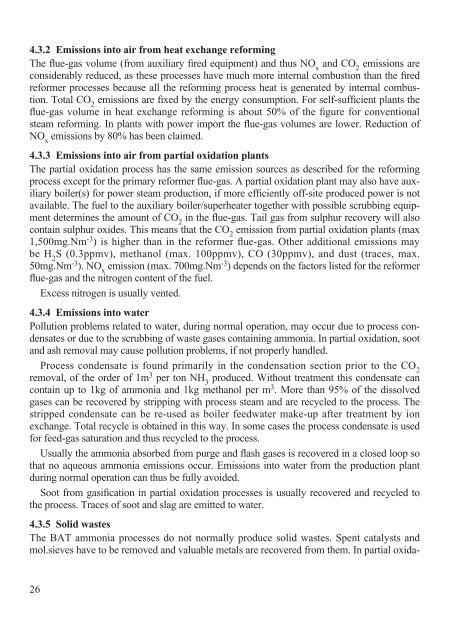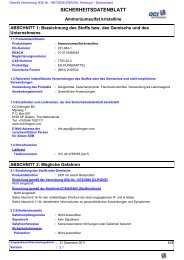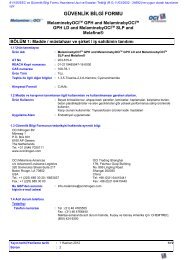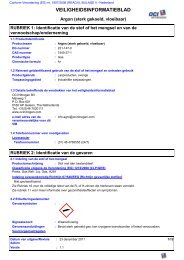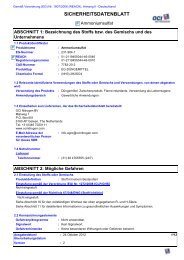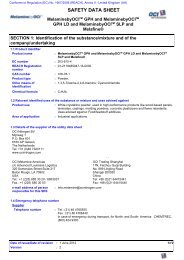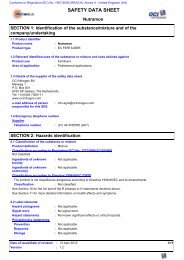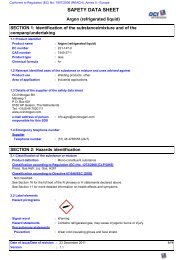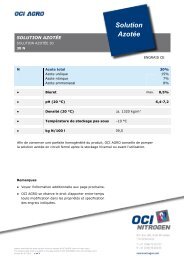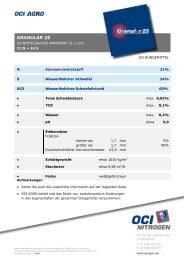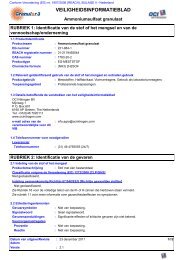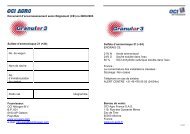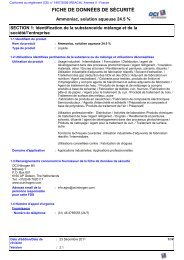PRODUCTION OF AMMONIA - OCI Nitrogen
PRODUCTION OF AMMONIA - OCI Nitrogen
PRODUCTION OF AMMONIA - OCI Nitrogen
Create successful ePaper yourself
Turn your PDF publications into a flip-book with our unique Google optimized e-Paper software.
4.3.2 Emissions into air from heat exchange reforming<br />
The flue-gas volume (from auxiliary fired equipment) and thus NO x and CO 2 emissions are<br />
considerably reduced, as these processes have much more internal combustion than the fired<br />
reformer processes because all the reforming process heat is generated by internal combustion.<br />
Total CO 2 emissions are fixed by the energy consumption. For self-sufficient plants the<br />
flue-gas volume in heat exchange reforming is about 50% of the figure for conventional<br />
steam reforming. In plants with power import the flue-gas volumes are lower. Reduction of<br />
NO x emissions by 80% has been claimed.<br />
4.3.3 Emissions into air from partial oxidation plants<br />
The partial oxidation process has the same emission sources as described for the reforming<br />
process except for the primary reformer flue-gas. A partial oxidation plant may also have auxiliary<br />
boiler(s) for power steam production, if more efficiently off-site produced power is not<br />
available. The fuel to the auxiliary boiler/superheater together with possible scrubbing equipment<br />
determines the amount of CO 2 in the flue-gas. Tail gas from sulphur recovery will also<br />
contain sulphur oxides. This means that the CO 2 emission from partial oxidation plants (max<br />
1,500mg.Nm -3 ) is higher than in the reformer flue-gas. Other additional emissions may<br />
be H 2 S (0.3ppmv), methanol (max. 100ppmv), CO (30ppmv), and dust (traces, max.<br />
50mg.Nm -3 ). NO x emission (max. 700mg.Nm -3 ) depends on the factors listed for the reformer<br />
flue-gas and the nitrogen content of the fuel.<br />
Excess nitrogen is usually vented.<br />
4.3.4 Emissions into water<br />
Pollution problems related to water, during normal operation, may occur due to process condensates<br />
or due to the scrubbing of waste gases containing ammonia. In partial oxidation, soot<br />
and ash removal may cause pollution problems, if not properly handled.<br />
Process condensate is found primarily in the condensation section prior to the CO 2<br />
removal, of the order of 1m 3 per ton NH 3 produced. Without treatment this condensate can<br />
contain up to 1kg of ammonia and 1kg methanol per m 3 . More than 95% of the dissolved<br />
gases can be recovered by stripping with process steam and are recycled to the process. The<br />
stripped condensate can be re-used as boiler feedwater make-up after treatment by ion<br />
exchange. Total recycle is obtained in this way. In some cases the process condensate is used<br />
for feed-gas saturation and thus recycled to the process.<br />
Usually the ammonia absorbed from purge and flash gases is recovered in a closed loop so<br />
that no aqueous ammonia emissions occur. Emissions into water from the production plant<br />
during normal operation can thus be fully avoided.<br />
Soot from gasification in partial oxidation processes is usually recovered and recycled to<br />
the process. Traces of soot and slag are emitted to water.<br />
4.3.5 Solid wastes<br />
The BAT ammonia processes do not normally produce solid wastes. Spent catalysts and<br />
mol.sieves have to be removed and valuable metals are recovered from them. In partial oxida-<br />
26


